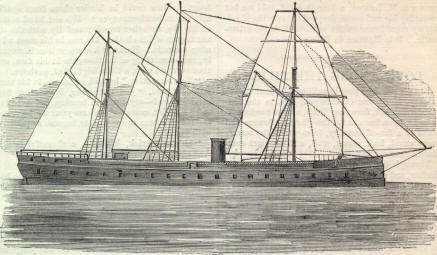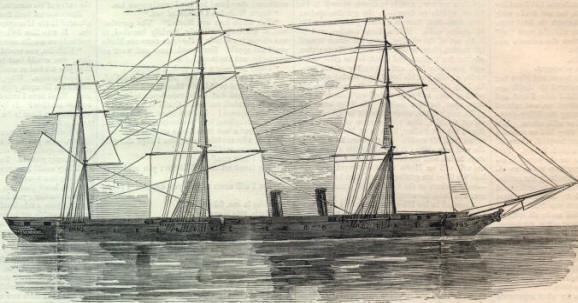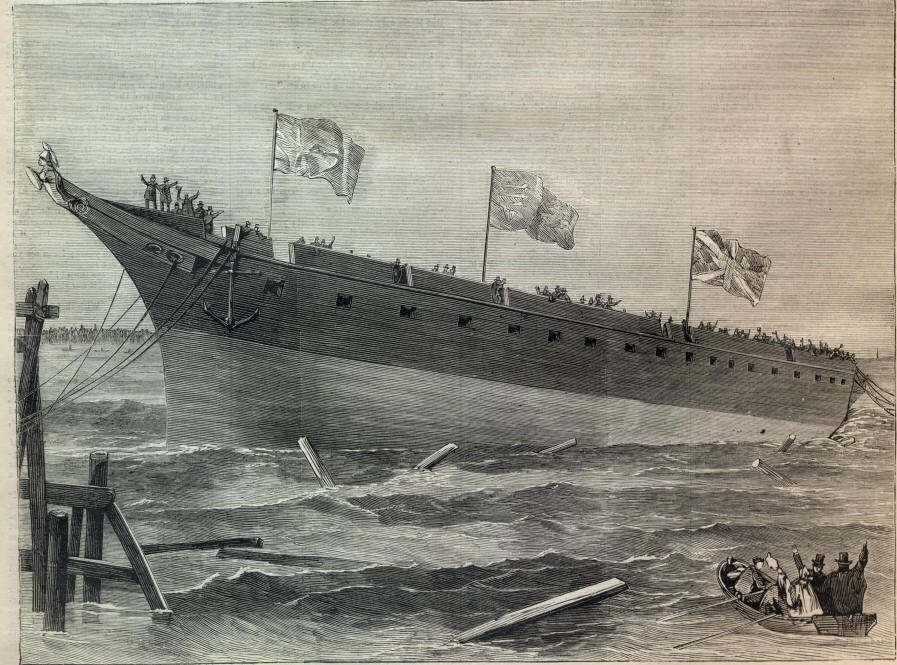|
This Site:
Civil War
Civil War Overview
Civil War 1861
Civil War 1862
Civil War 1863
Civil War 1864
Civil War 1865
Civil War Battles
Confederate Generals
Union Generals
Confederate History
Robert E. Lee
Civil War Medicine
Lincoln Assassination
Slavery
Site Search
Civil War Links
Civil War Art
Revolutionary War
Mexican War
Republic of Texas
Indians
Winslow Homer
Thomas Nast
Mathew Brady
Western Art
Civil War Gifts
Robert E. Lee Portrait
|
HARPER'S WEEKLY.
THE NEW IRON-PLATED
WAR-SHIP "LA GLOIRE" AS SHE WILL BE.—SCALE, 1/839 OF FULL SIZE.
REVOLUTION IN NAVAL
WARFARE.
SHOT-PROOF IRON STEAMSHIPS.
WE engrave herewith
pictures of the famous new experiments in ships of war—the British
Warrior, and the French La Gloire, which are just now attracting so much
attention. A British authority gives the following description of the two
vessels : " When the Warrior was designed, La Gloire was not afloat. All
that was then known of her in England (and we have learned but little more
of her since) amounted to this: that she was a timber-built ship, very
much resembling one of our line-of-battle ships cut down, and cased from
end to end with iron plates 4 1/2 inches thick ; that she was 252 feet 6
inches long (between the perpendiculars), 55 feet broad, and 27 feet 6
inches deep below the water-line; that her ports were to be 8 feet 6
inches apart, and from 5 to 6 feet above the water ; that she was to be
lightly rigged, and to possess but small sail-power ; that her engines
were to be of 900 (nominal) horse-power ; that her estimated speed was
about 11 knots per hour; and that she was to carry 34 guns on her
main-deck, each firing 54-lb. shot, and two shell guns forward. The
problem which the naval architects of this country were called upon to
solve was this: what kind of vessel will best enable our seamen to contend
successfully against La Gloire and similar ships? "Before this problem
came practically under the consideration of the naval architects at
Whitehall, Mr. Scott Russel, the designer and builder of the Great Eastern,
had, it appears, submitted
to the Controller of
the Navy designs for an iron-plated ship of war, in which was adopted a
novel and ingenious device — that of defending only the central portion of
the ship with armor, leaving her extremities free from its encumbrance.
"From the fact that Sir John Pakington and his colleagues insisted upon a
speed of 14 knots an hour, and the power of carrying provisions for four
months, it is manifest that they resolved to oppose to La Gloire a real
sea-going ship of war; not a mere floating battery, nor a craft that
would have to keep the land in sight, but a ship which should be fit to
take the open sea, and, if need be, to bear the flag of old England once
more to the enemy's coasts. They clearly were determined, if not to
reassert our old supremacy upon the ocean, at least to prevent supremacy
being asserted by others. To this end, a high speed, and the power of
keeping the sea for months together, were absolutely essential. This
rendered several specific qualities necessary. For example, a sea-going
ship must be furnished with masts and sails of sufficient dimensions to
keep her perfectly manageable and sea-worthy in all weathers, under sail
alone. No steamship of war
can carry sufficient coals
to keep her under full steam for more than a few days, and, consequently,
neither the blockade of an enemy's port nor the pursuit of a hostile
fleet—operations from which the British navy has never shrunk hitherto—can
be performed by ships without large sail-power. It was necessary, again,
to place the battery of such a ship at a considerable height above the
water—not less than 9 feet, say ; for a vessel whose battery is nearer the
water, has to close her ports and silence her guns at the first approach
of rough weather, and is altogether incapable at such a time of defending
herself efficiently against a ship that has the advantage of her in this
respect. "In all these features the Warrior is, beyond question, superior
to La Gloire. We assume here, to start with, that her speed will be at
least two knots an hour greater than that of the latter ship. La Gloire,
with her form, dimensions, and engine power, can not keep up an average
speed of more than 11, 1/2 knots an hour ; while, on the other hand, it is
pretty certain that the Warrior, with her form, dimensions, and engine
power, will prove capable of an average speed of at least 13 knots. " She
will likewise have the advantage of her in respect of sail-power, inasmuch
as while La Gloire is lightly rigged for channel service only, the Warrior
is furnished with the masts, spars, and sails of an English 80-gun ship.
"A comparison of the armaments of these extraordinary vessels is not a
very important matter ; because, supposing La Gloire to be impregnable, no
British officer would think of spending time in exchanging shot or shell
with her, when he had a ship of the Warrior's speed under his command. He
would, of course, immediately close with her, and carry her by the good
old English method of boarding—this being, in fact, the prime object of
her great speed. With the 'tops' and rigging of the Warrior swarming with
riflemen,
no crew could be
prevailed upon to keep the weather-deck of La Gloire when once the faster
ship had closed upon her; and although provision for deck defense against
boarders has been made in the French ship, we, at least, can not believe
that her tri-color would long continue flying. The height of the Warrior's
sides is eminently favorable to the operation, as the men could readily
leap from them upon the low deck of La Gloire.
"Notwithstanding these
considerations, however, it may be well to state what the armaments of the
two ships are. La Gloire is supposed to carry 34 guns upon her main-deck,
all of them 54-pounders; and two heavy shell guns forward, with an oblique
screen in front of them. All her guns are, therefore, under the cover of
armor. In the Warrior, on the other hand, only 26 are protected ; but all
of them are to be large 68-pounders, each weighing 100 cwt. At long range,
neither ship could harm the other seriously ; at short range the 68-pounders
would be by far the most formidable weapons. But besides the 26 guns that
are protected, the Warrior can, and probably will, carry 12 additional
guns on the main-deck, of the same size as the others; and on her (Next
Page)
THE NEW IRON-PLATED
WAR-SHIP "WARRIOR" AS SHE WILL BE.—SCALE, 1/839 OF FULL SIZE
LAUNCH OF THE
IRON-PLATED WAR-SHIP. "WARRIOR."
|


